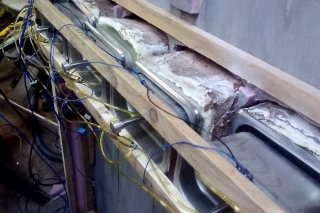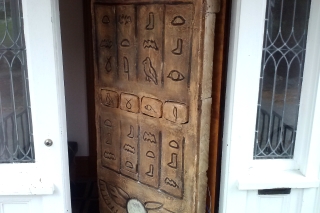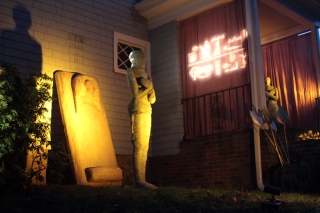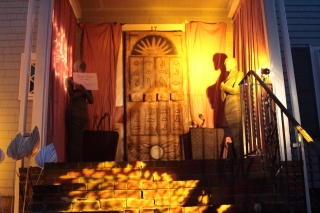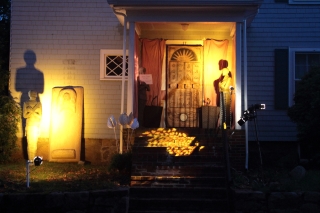The last couple of years has caused us to undertake a review of our technical capabilities. Too much had gone wrong or become unreliable. While the theme is usually our chief concern, this year the goal was to lock-down some of the basic building blocks of our theatrical show system.
The first item was video. The video is played back on a MedeaWiz Sprite with a DMX interface. We had tried to use video last year and it failed miserably because of a bad cable connection. It was a stupid problem to have, so that got addressed. But how to use it? A quick search of Halloween related videos on the Internet results in the idea of making bats fly out of the doorway.
Creating the video was fairly straightforward, but the key to making it feel creepy was in the audio. Without the sound, the images looked a bit like a Rorschach test. They needed that squeaky sound that bats make to add context. More importantly, it needed to sound like the bats were getting closer.
To make the bats sound menacing, multiple tracks were played across five channels of surround sound. The most distant chirping sounds were at the corners of the house. Closer-up were large wing flapping sounds nearest to the stairs. The wing flapping was not a real bat sound, but the idea of a bat flying close to your head.
The last channel was placed across the street. We used long-range Bluetooth to transmit the bats sounds to a speaker in our neighbor’s yard. This is a technical advance we will probably use in the future because it really messed with people. It was fun to watch people during the first three seconds of the video where they thought: There are bats. The bats are coming at me. The bats are everywhere.
One new piece of tech that we will definitely use every year was a new light beam trigger. We have used a light beam at the base of the stairs to start the show for years, but it always had the problem of re-triggering the show when people exited. We used to mitigate this problem by adding a delay before the show could be restarted, but that works only if people arrive at given rate.
The new trigger has two light beams. This is similar to the electronic turnstiles Disney used about a decade ago. A microcontroller board was programmed to check the order in which the beams were broken so we could determine the direction of movement. Going up the stairs starts the bat video. Going down the stairs made a cat screeching sound – just because we could.
Lastly, we upgraded our speaker system. The new speakers are more weather resistant and handle a lot more power. This was needed to reduce stress as much as wanting to improve sound quality. Rain is inevitable and this year was a perfect example. It was nice to have the speakers out all day in the rain without worrying about them. It was also nice to drive the smaller speakers by the stairs as hard a we wanted to.
The video below was mixed to be in surround sound, but YouTube re-mixes it down to stereo, so you can’t really get the full effect. Next time we invite you over, make sure to ask to see the version on the home server.

